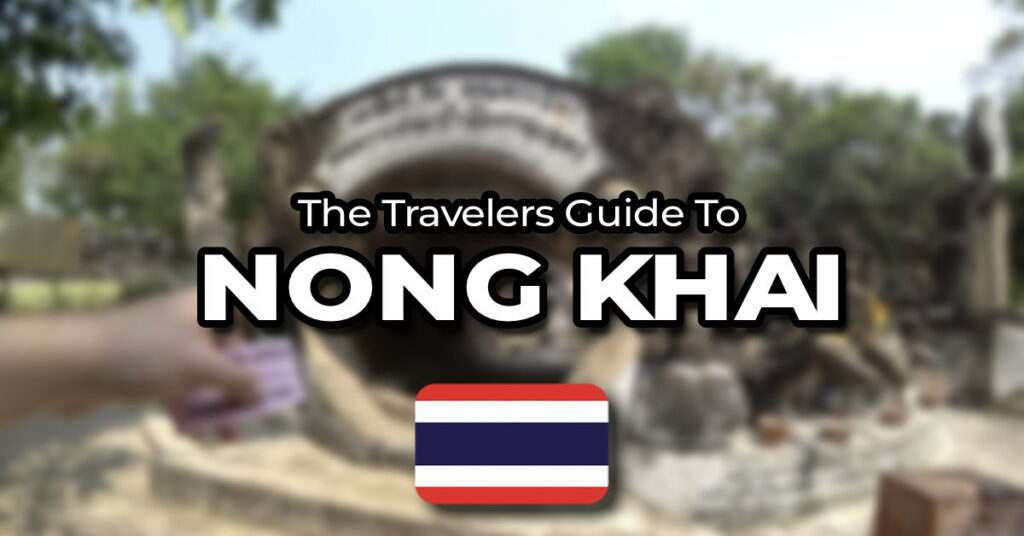So, you’re here to cross the border into Laos, or just to visit – but what things are there to do here in Nong Khai? In this article, I’ll cover everything including some uncovered gems that no other publication has spoken about online, drenched in a deep history of a very difficult past. Why trust me? I’ve traveled through Thailand for over 6 months (as of writing), can speak Thai well and that helps me uncover the deeper, more hidden parts of areas.
Things To Do in Nong Khai (With Interactive Map)
Like a lot of border towns, Nong Khai doesn’t have much to do. But there is enough to keep you busy before you head over the border into Laos and it is one of the better border towns to border run in Thailand as there’s a lot more when opposed to Chiang Khong or other crossings.
Additionally, Nong Khai is a town steeped in rich history. Unfortunately, there aren’t many plaques or remnants of the past to explain the areas. However, with this guide, you’ll know the historical importance of these places, which make it a far more interesting visit.
Remnants From The Lao Civil War & Indochinese Refugee Crisis

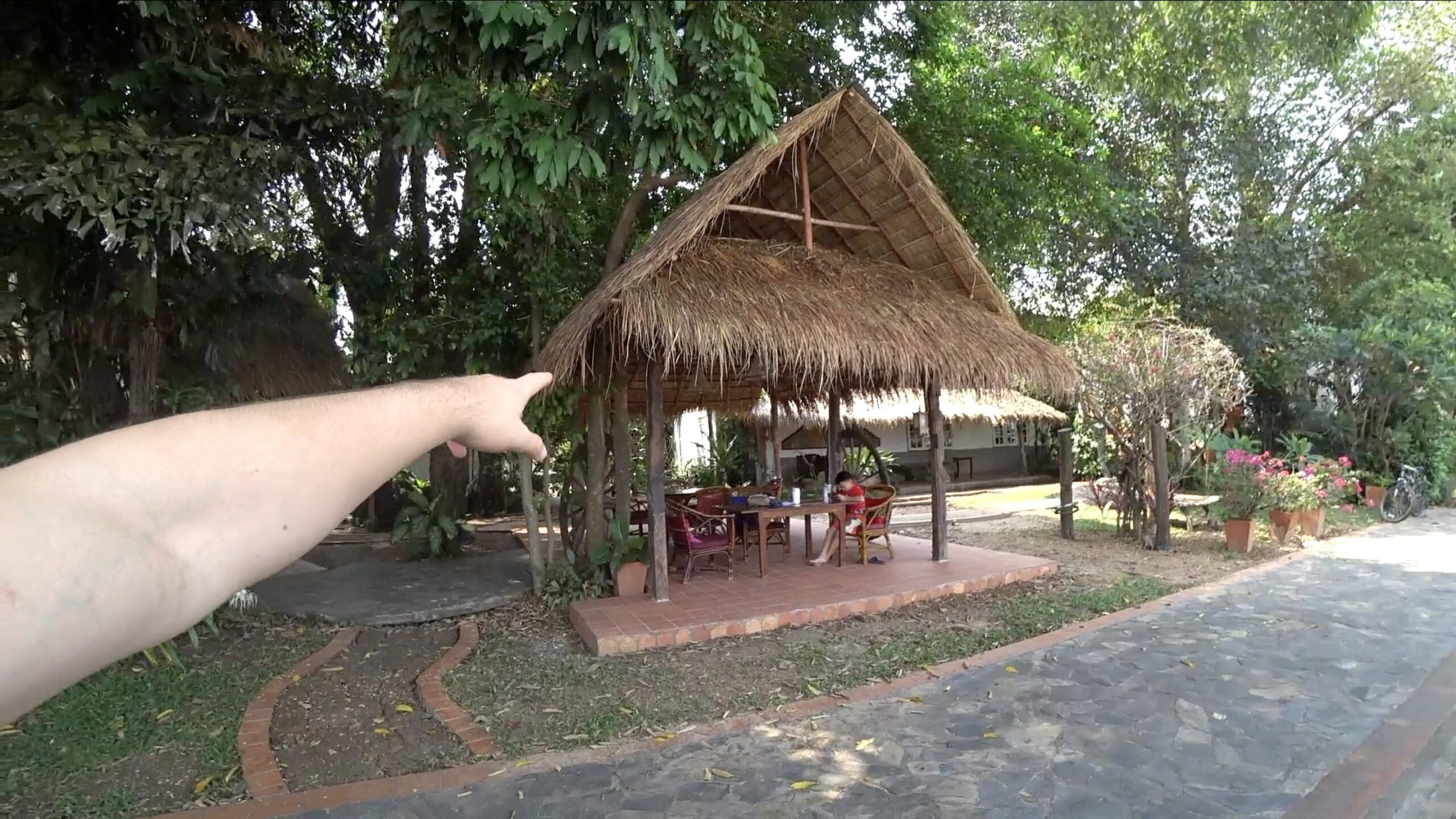
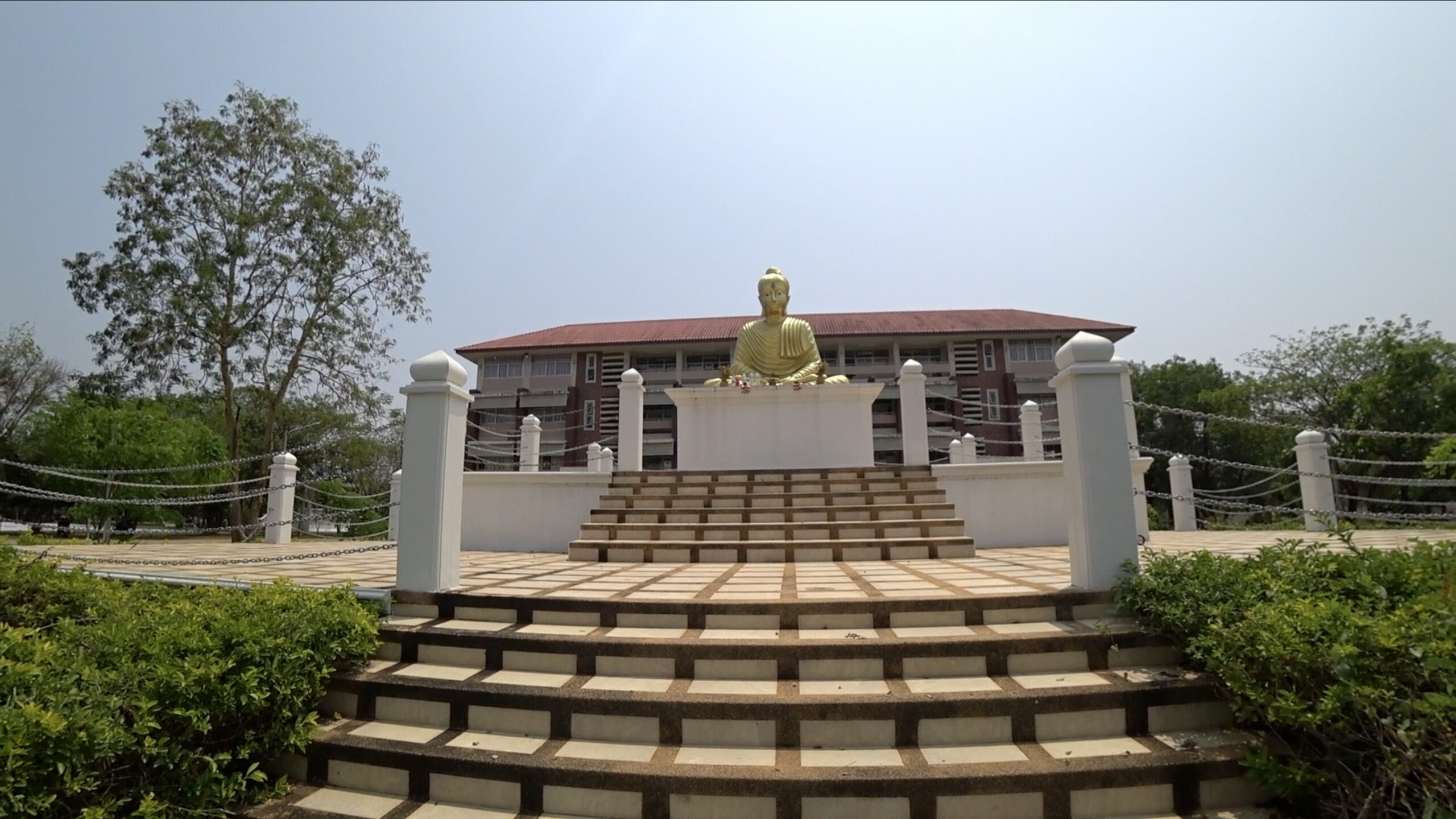


Here in Nong Khai, the 2nd largest refugee camp from the Lao civil war for, Lao, Hmong, Tai Dam and other ethnicities fleeing the war would be housed here. Up to 24,000 people were here during it’s peak, and the camp was open from 1975-1992.
Many of its inhabitants fled the war across the great Mekong river, swimming against the harsh currents. Unfortunately many didn’t make it across this gap, dying in the currents of the rivers. Moreover, many would travel for days to make it to the crossing in groups as large as 70+; many of these groups would arrive significantly smaller due to the losses experienced on the journey.

Unfortunately, there isn’t a great deal of information about where the original location is. However, with some old directions and help from a local, I found the original location, which is now a peaceful Technical College, located about 6km from Nong Khai’s Administration office.
There’s no tourist attraction here to see, and it’s not technically open to the public. However, if you ask the person at the gate, they may let you go in and take a look around the old grounds (they let me freely roam around after I said I was here because of the history).
Inside the grounds, there are a few temples, but I’m not sure if they are there to remember the people who struggled here, or if they’re simply for school prayer/meditation. Regardless, it’s still an interesting spot to visit in Nong Khai to imagine the journey these people took to survive the awful treatment of the traitors in Laos, after the civil war.
Additionally, if you stay at Mut Mee guesthouse (or eat a meal there), the owner knows a great deal about the history and grew up during the time of the civil war. She is an old professor from the Technical College, and knows her stuff. I’m sure if you went, ordered a coffee or a meal/stayed there she’d be more than happy to help you out with a little information.
If you do go, you’ll find an old pillbox (now a shack in the hotel), that the Thai soldiers supposedly used to shoot back at the Pathet Lao who were killing the “traitors” fleeing newly, communist Laos.
Sculpture Park (Sala Keo Kou)
video time-stamped to sculpture park part
This is a park that is home to hundreds of huge 4-7 story sculptures made out of concrete. Although these look incredibly old, they were built very recently, being erected only 40-50 years ago, after the great Indochinese Refugee Crisis.
Interestingly a Thai/Lao man (Bunluea Sulilat) built this park from scratch, after having to flee from Laos to Thailand during the civil war. The detail, and craftmanship that has gone into each and every statue is nothing short of amazing, and the sheer size of some of them is breathtaking (see pictures below).
Bunluea spent most of his life dedicated to spiritual teachings, learning from a monk/mystic in Laos called Kaew Ku (hence the name of the park), and you can see this in his work – with the sculptures largely influenced by Buddhist and Hindu traditional art.
It took him 20 years to complete the sculptures and finish the park, which costs 40 baht ($1.10-1.20 USD) for foreigners.
If you’re going to Laos, it’s also worth noting that, in Laos, just across the river from Nong Khai, Bunluea also built a different sculpture park called “Buddha Park”. This park contains sculptures that are very similar to those found in Nong Khai’s own park
The sculptures are all inspired by art and depictions of gods from the Hindu & Buddhist religions with some small influences from Islam shown in the temple you can visit there.
Bunleua died here in Nong Khai, in 1996, and was laid to rest inside this grounds, mummified on the 3rd floor of the temple. You can see his body through a door in a dome-shaped coffin.
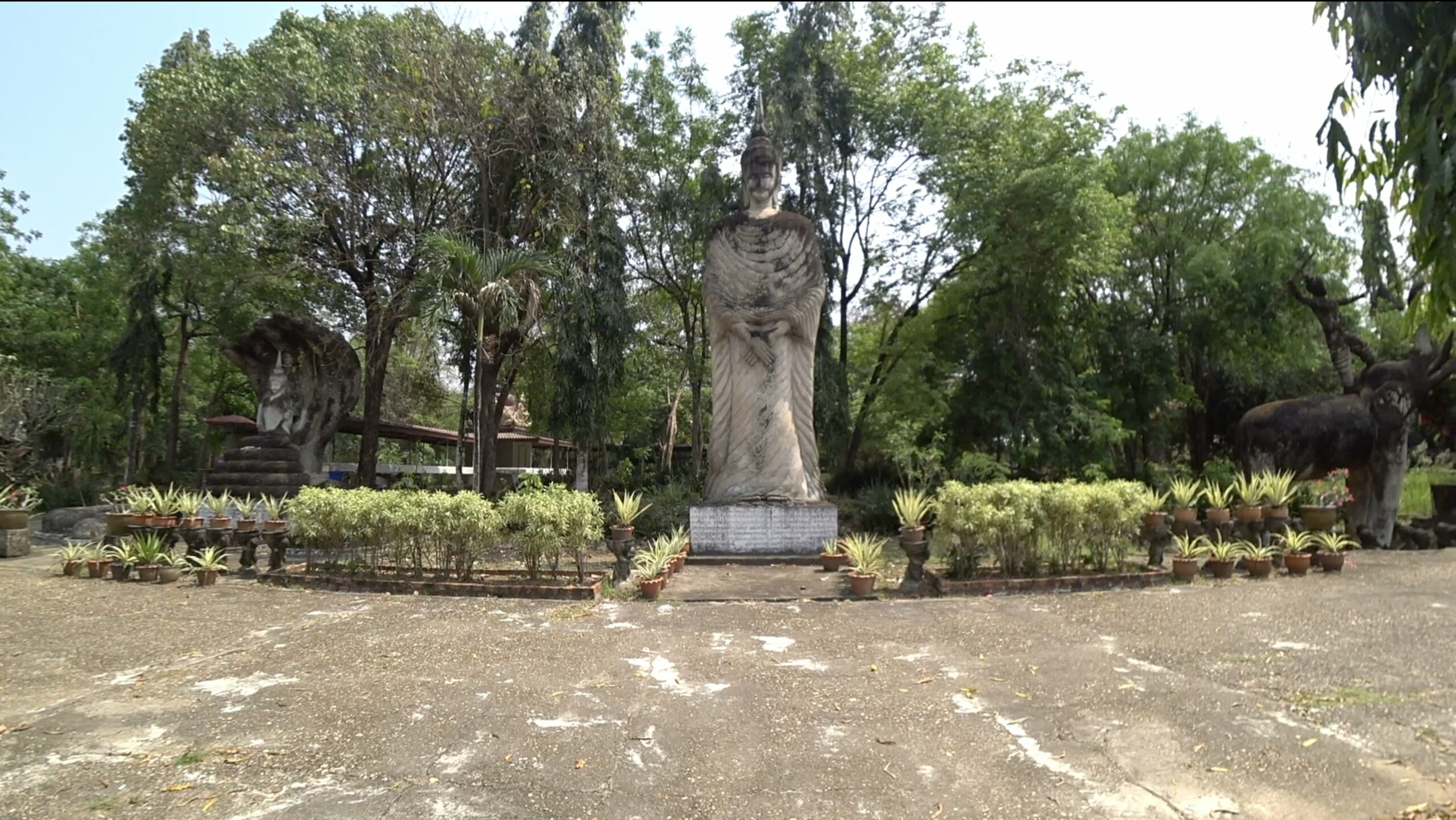

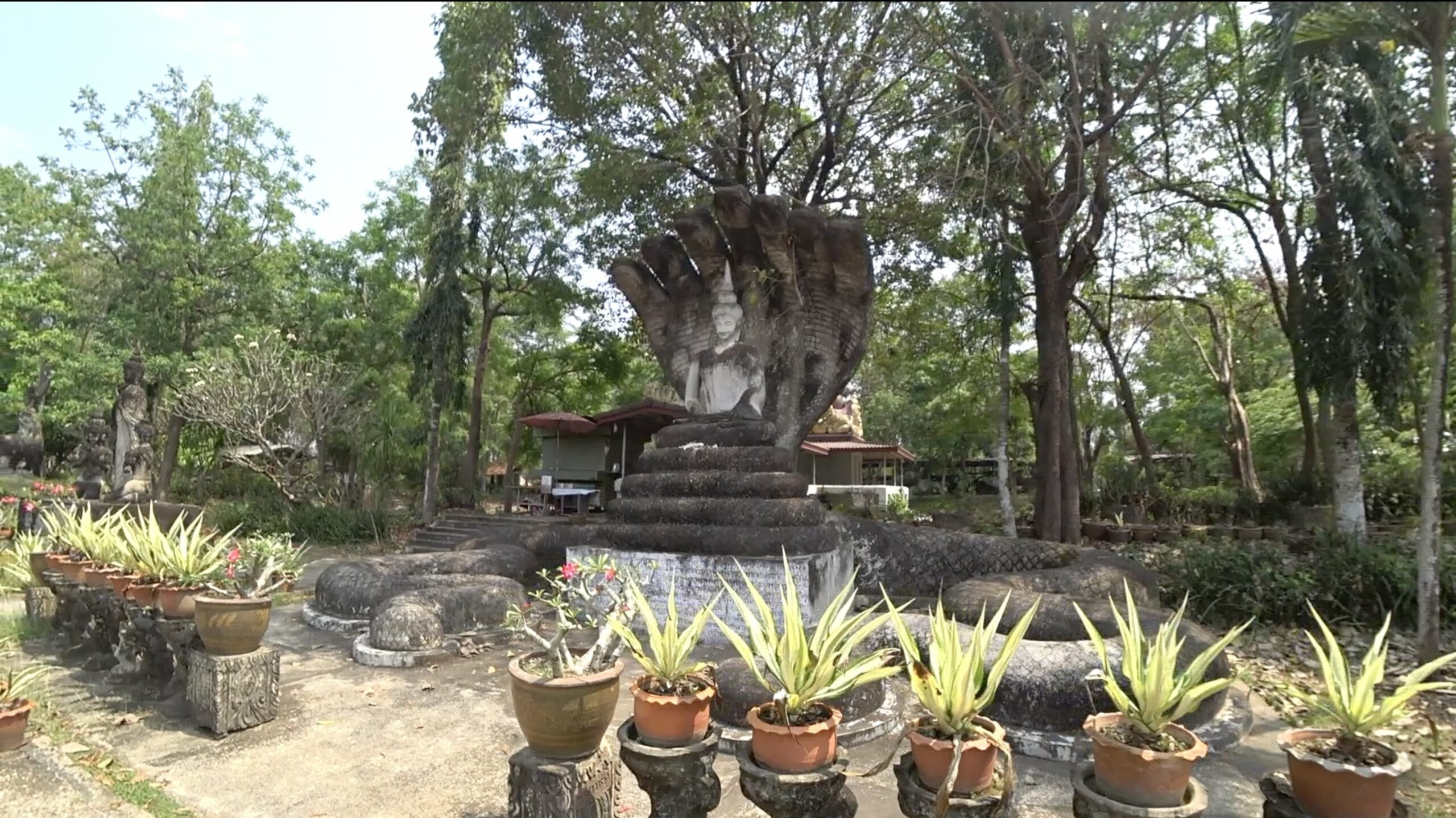
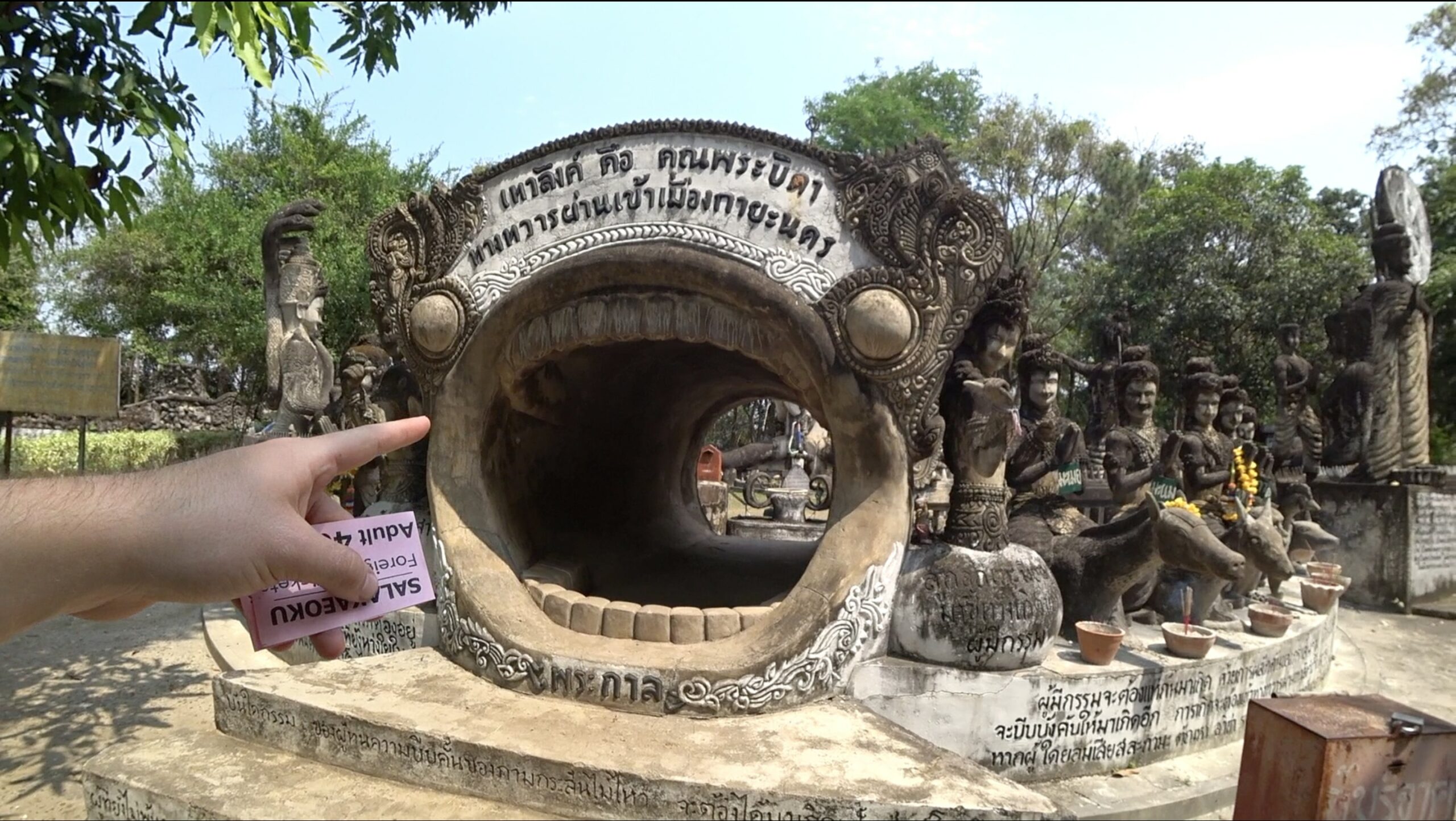
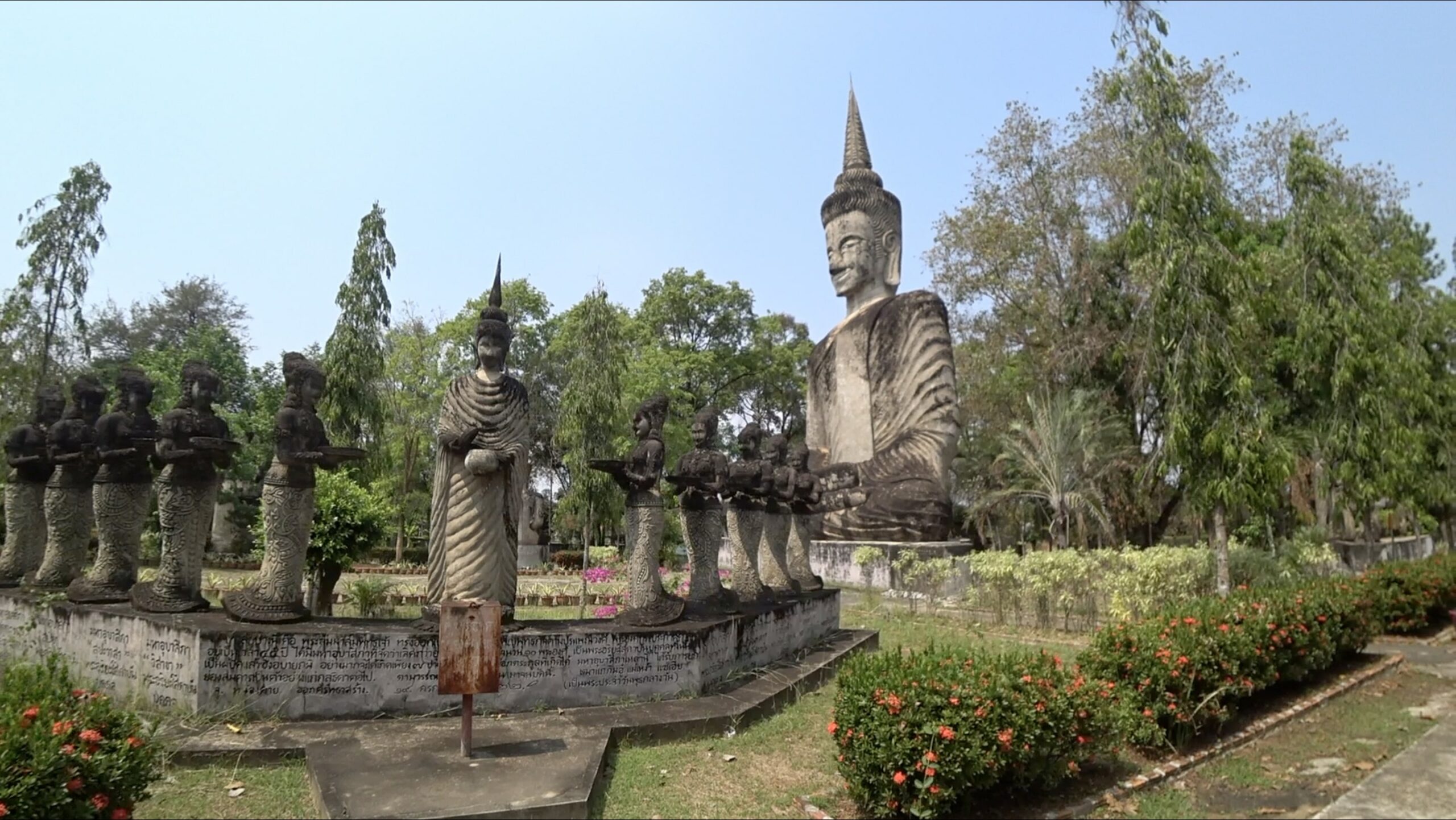
There is also an interesting myth/legend here that says Bunleua carved a curse into the half-built statue (located at the front of the park), damning a Policeman who questioned what he was doing after he fled to Thailand and started construction of the park. The myth says that they thought Bunluea was a foreigner, and due to Thai law, foreigners are not allowed to build on Thai land, so questioned him.
There are no sources to back this up, but some of the locals told me this during my visit. I have no idea how true or untrue it is, but it’s an interesting tale nonetheless.
Wat Phrathat Klang Nam & The Holy Relic
At a temple called Wat Phrathat Klang Nam, there is an ancient stupa (a dome-shaped structure that’s used as a Buddhist shrine) that is said to have eroded and fallen into the Mekong River in 1847. Here, by the temple, you can still see the ruins during dry season (March – September) poking out of the water. Legend has it that it once housed 9-foot bone relics.
It’s only a small triangle-shaped rock that is jutting out of the water, and there’s a yellow flag attached to it, to make it more visible. You can only see it during dry season, but there is also a replica that has been built across from it, that you can look around, then stare across the river and envision just how hard the journey across that great big river gap must have been for those fleeing their homes in 1975.
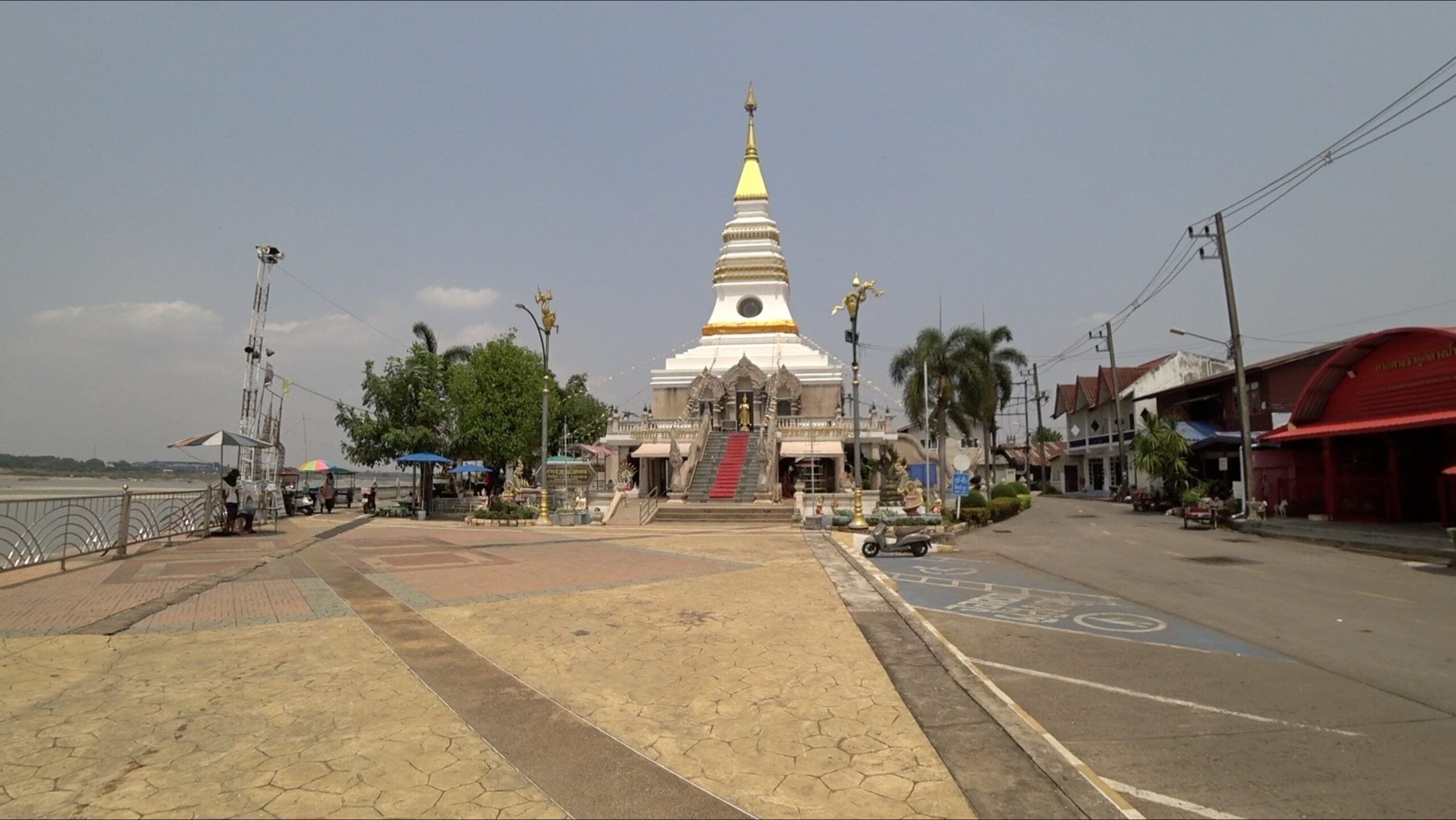
It’s also said that temples like these would house refugees temporarily, giving them food and shelter, before they moved onto camps or continued their journey fleeing from the Pathet Lao. Some temples would put up tents for refugees fleeing to give them temporary shelter.
Wat Phrathat Klang Nam could have been one of these temples, although it can’t be said for sure, as there isn’t much recorded, written history for this. Maybe other temples did too, but it’s unsure which ones.
Wat Pho Chai
This is the main temple found in Nong Khai, and houses a huge bronze Buddha statue that has a gold head. This is used as Nong Khai’s provincial image, and is said to date back to the Lan Xang kingdom in the 1700s. Legend has is that the Lan Xang kingdom ruler’s daughters had 3 Buddha statues cast, Pra Suk, Pra Sai and Pra Soem – Pra Sai is the statue in Nong Khai’s temple currently.
These 3 Buddha statues were said to have been plundered during the Siamese invasion of the Lan Xang kingdom (Laos) in 1778, with only Pra Sai and Pra Soem making it across the river, and Pra Suk sinking into it. Pra Soem was later moved to Bangkok, and only Pra Suk remains here.
(the murals surrounding the sides of the walls, also depict the Siamese invasion of Laos across the Mekong river).
This temple is the most visited in the region and the Buddha image is one of the most loved in the province. Many people travel to pay their respects and see this Buddha image, and specifically during Songkhran (Thai New Year), there are some special ceremonies that take place around this particular Buddha statue, where people douse the Buddha’s head with perfumed water.
There is additionally a festival that takes place every year in June, where people gather to set off fireworks.
Walking Street Nong Khai
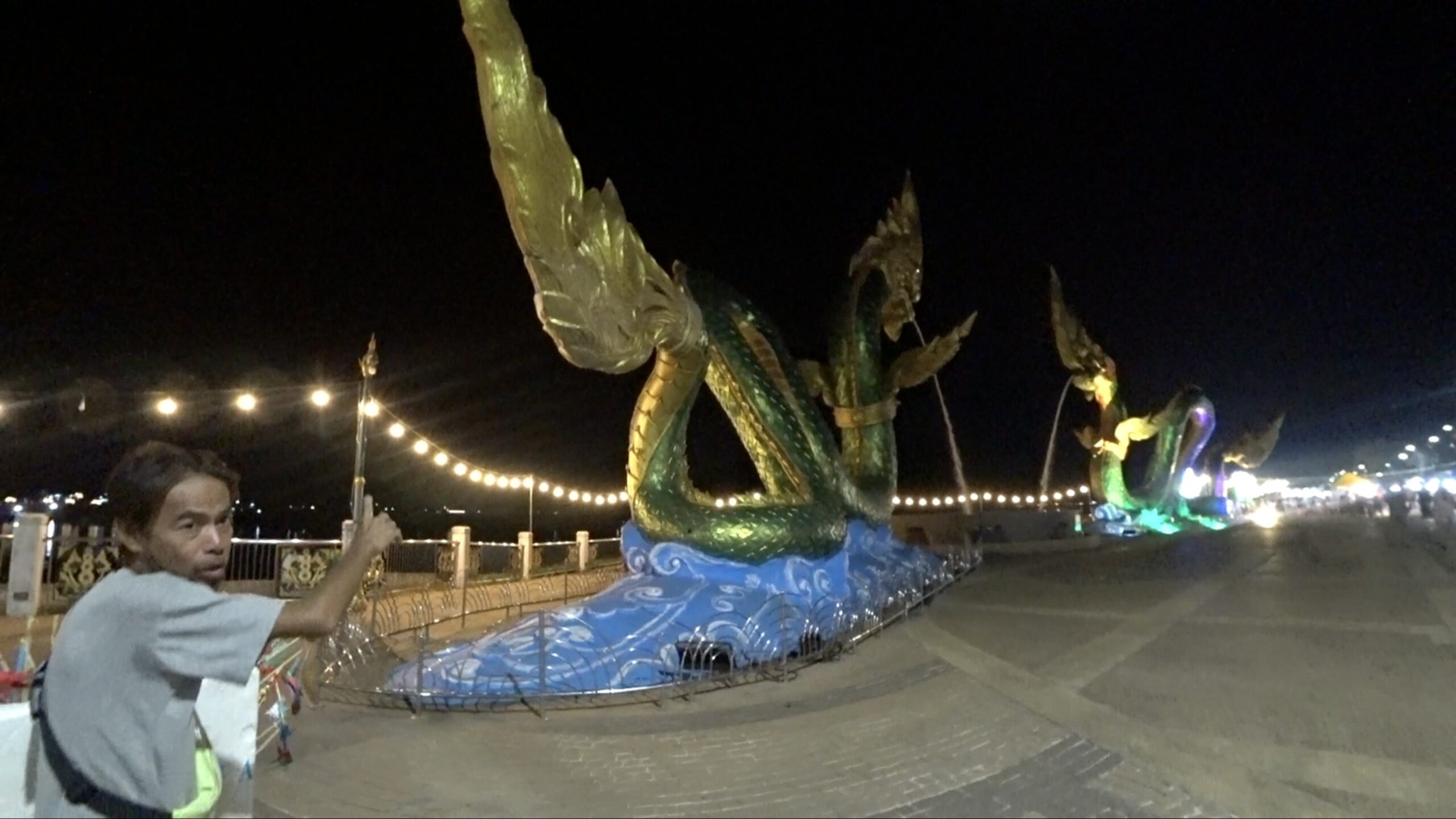
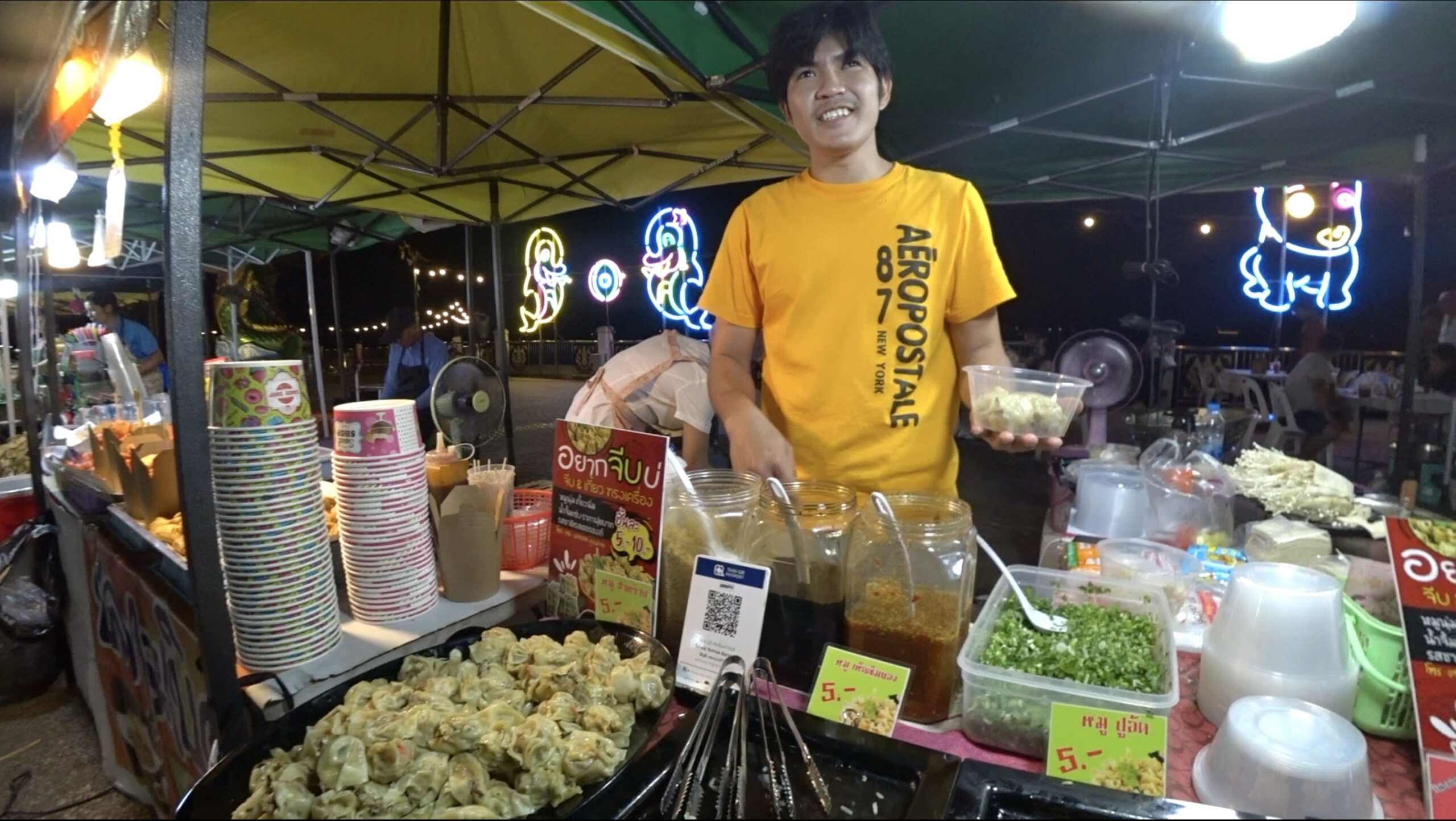
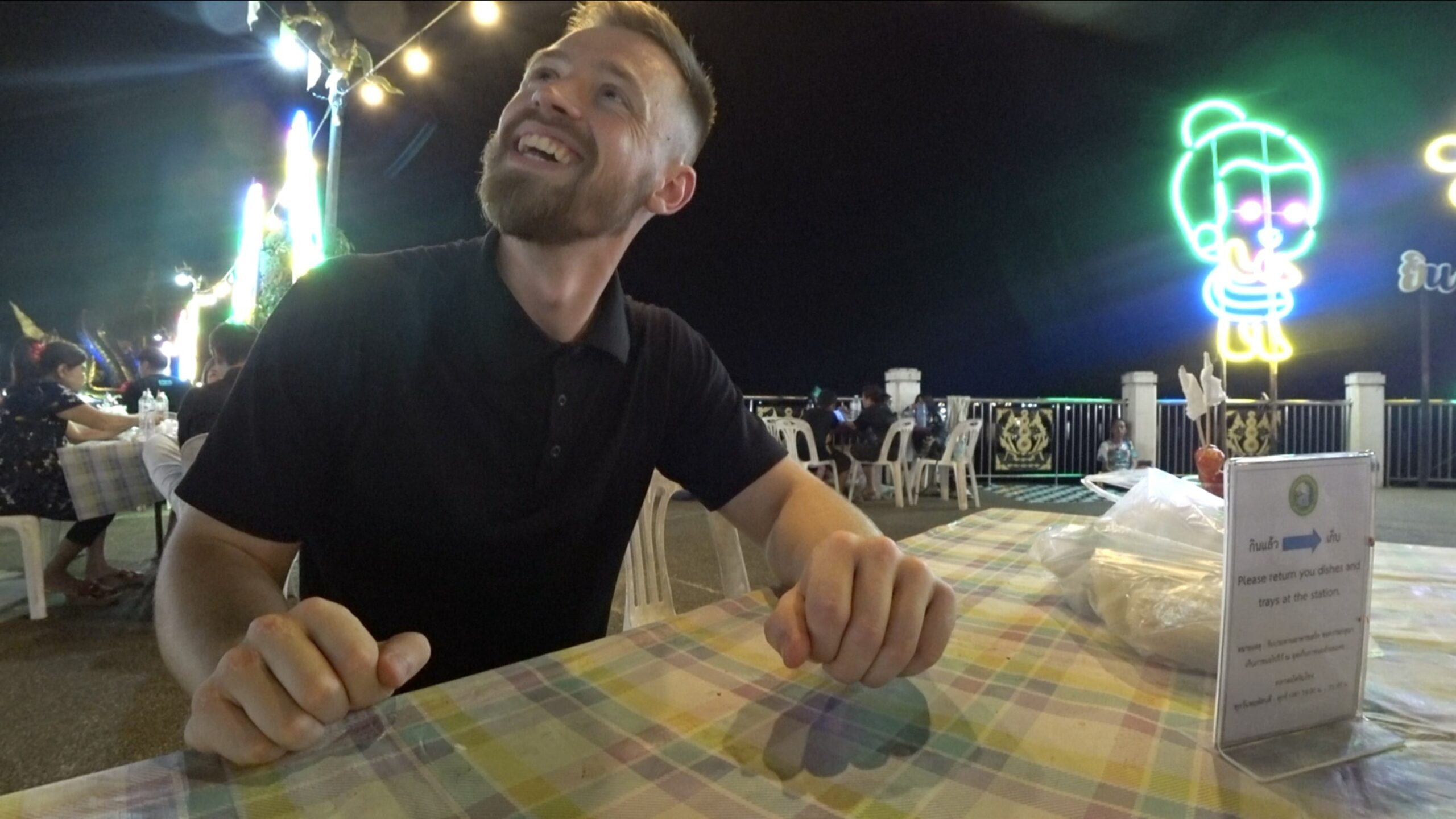
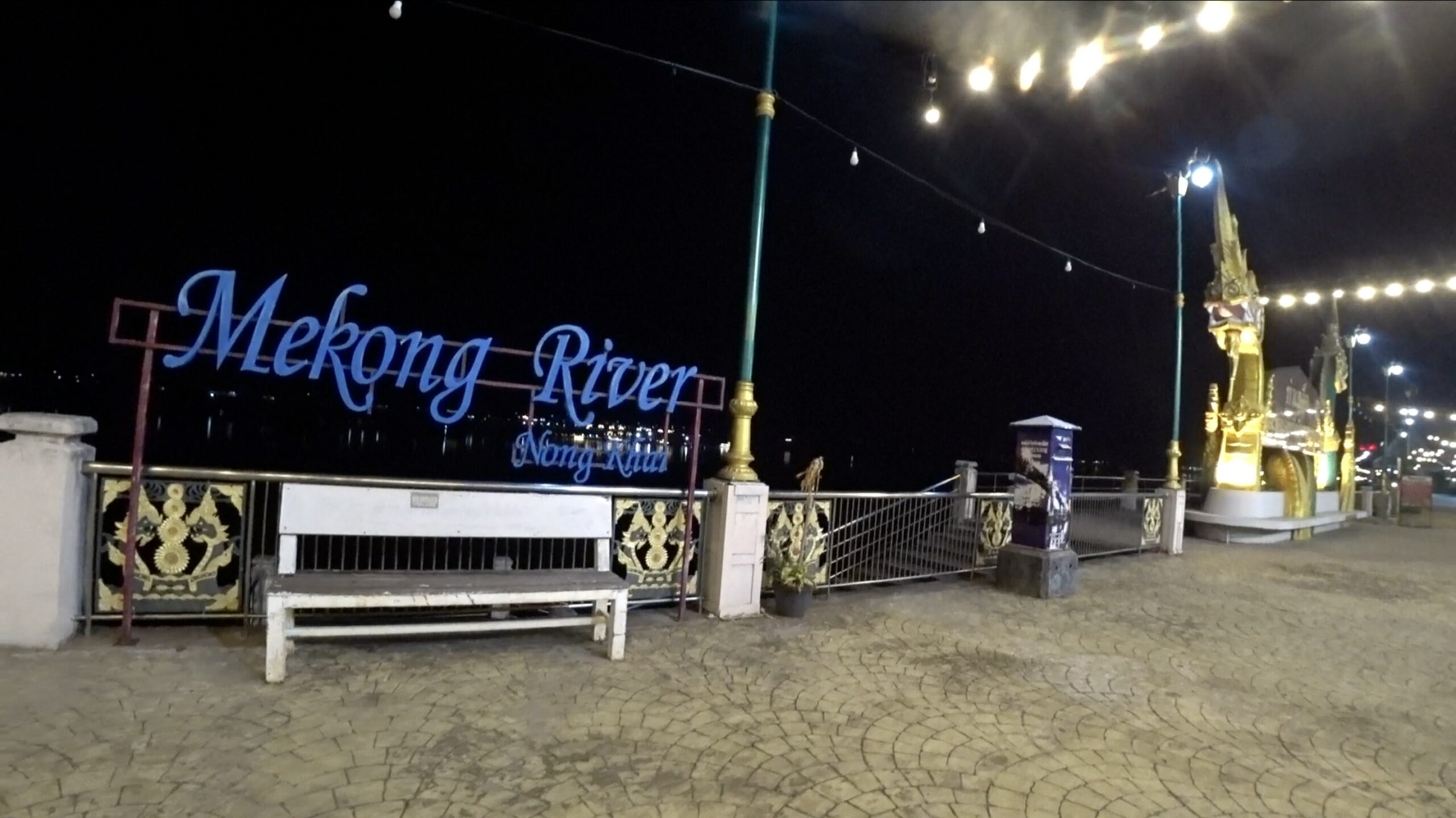
The walking street is a huge market that has all kinds of different foods to try. Here you can find anything from sweet desserts, pies, to savoury dishes like grilled meats, fish, curries etc. It’s much like many night markets you’ll find all throughout Thailand, but extremely large with a great deal of options and a beautiful view of the river.
You’ll also find music playing here, and on the walk to the market there are usually a lot of activities going on such as exercise classes, dance classes and more.
It’s a great place to take a walk, bike or socialise with people, have a bit to eat, and sit by the river with some beautiful lights. It’s also right next to Wat Pho Chai, the Naga Statue, and on the way to the Sculpture Park, so it’s easy to make a stop while you’re en route to other attractions.
Along the walk, you’ll also find big signs, with stairs to a platform at the top. You can walk up the stairs to get a great arial view across the river into Laos.
There are additionally plenty of bars, restaurants and small food counters you’ll find during the walk to the big market at the end of the promenade.
River Boat Rides
By the river near Wat Phrathat Klang Nam, you can find fisherman and long boat owners who can take you on river tours for a small fee (not sure how much). This takes you along the Mekong for a couple of hours, and takes you closer to Laos before you cross the border.
You can also get a restaurant cruise along the river, where you’ll be able to eat while watching the incredible sunset. The food isn’t the best, but the view is more than worth it and it’s a great thing to do if you’re staying in Nong Khai for a couple of days,
Nong Khai’s Museums
There are 2 museums in Nong Khai, both are free entry and have images of some of the town’s most important figures, monks, and artifacts. You’ll find a lot of pictures here, with enough information in English to get by. Although, there’s not an incredible amount of English information on offer here, it’s still an interesting visit.
If you’re interested in history this is worth a visit, but if you could miss it.
Craft Beer By Nong Khai’s Mekong River
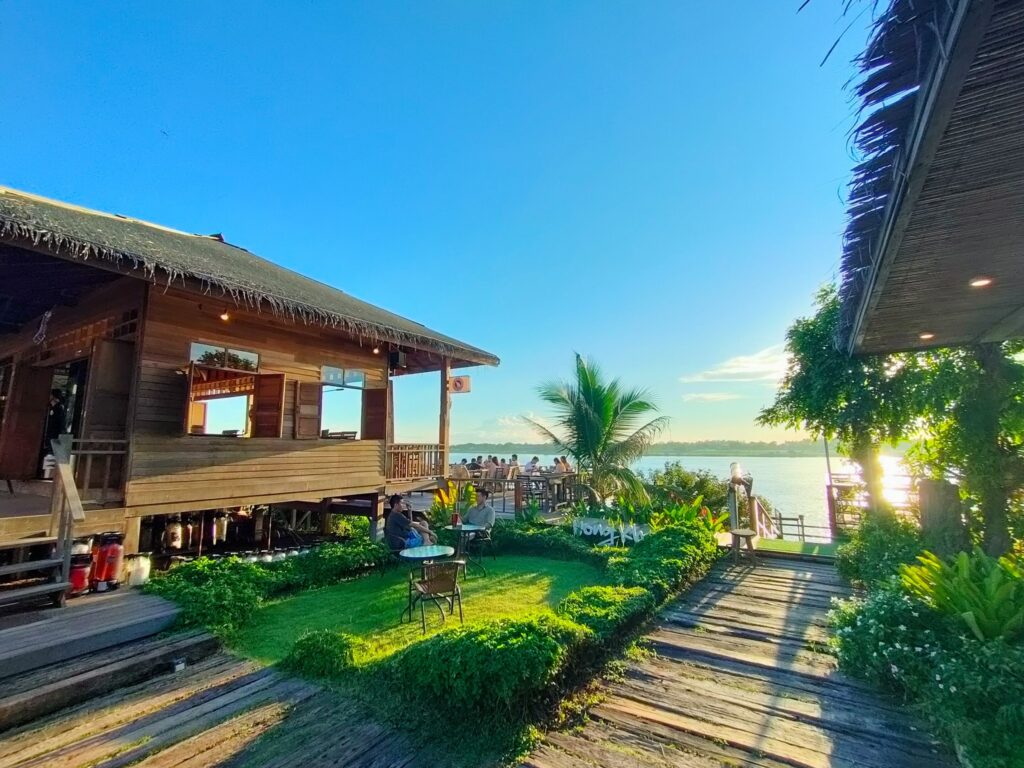

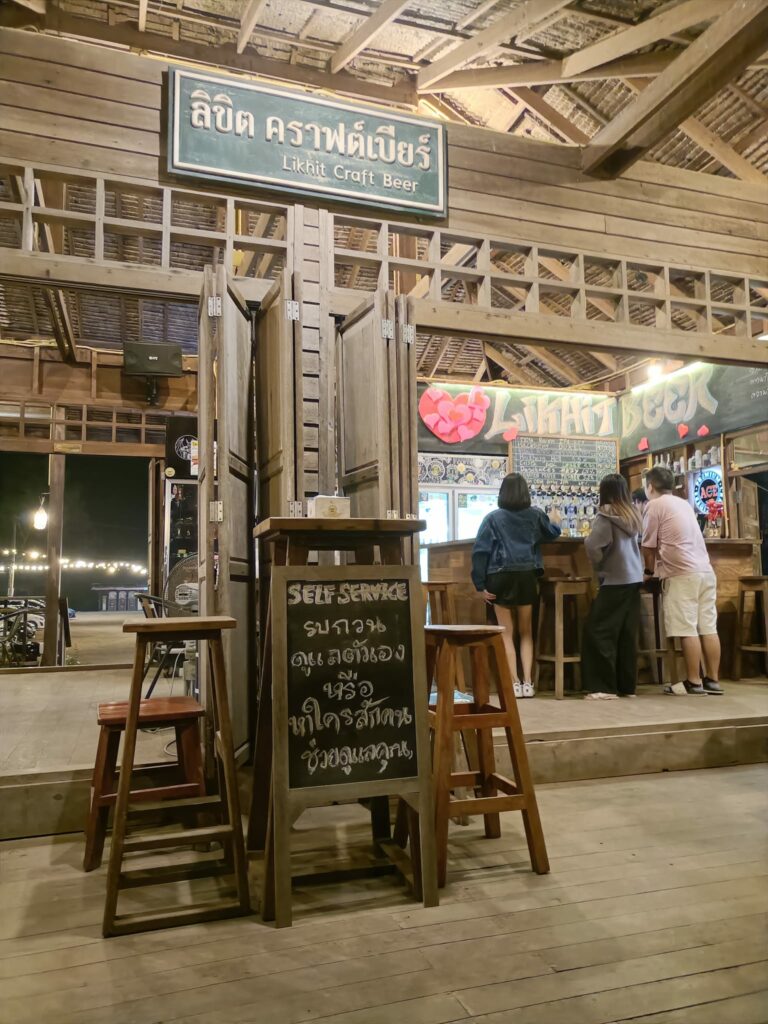
If you’re into beer, coffee or food this is a great visit. On site you’ll find a cafe, and a craft beer bar/restaurant. The beers are reasonably priced (for craft beers), with full pints setting you back around 300-400 baht (depending on the beer). They also serve food here, which is fantastic too.
If you want to relax, sipping a high-quality beer by the river, watching the sunset or the time go by, then you should definitely visit this spot.
Just next-door to it is a great coffee spot called “Gotong Bike Coffee” – a fantastic place to pass by on a walk by the river in the morning, for a morning coffee with the sunrise.
Getting Around Nong Khai
Renting A Motorbike
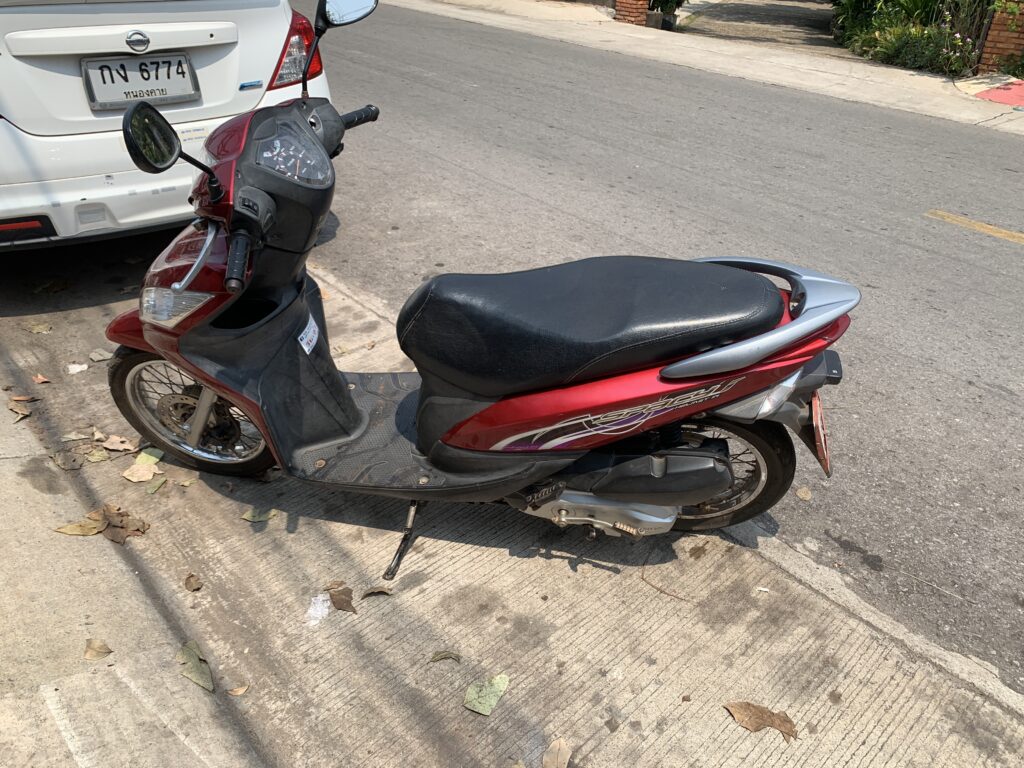


There seems to only be one motorbike rental place that’s accessible. The rental cost as of writing is 200 baht ($5.50) per day. It was a decent rental for travelling short distances, but if you want to go further, the bikes provided weren’t in great condition. Many times the bike wouldn’t restart and you had to rev the engine while pressing the ignition to get it going.
Speedometer didn’t work, brakes were OK… the usual stuff for cheap rentals like that.
Great guy running the place, and allowed us to leave the bike at the border with the keys locked in the boot. He picked it up from the parking spot it was left at later on, and it gave us a nice ride to the border before crossing.
Renting A Bicycle
You can rent bikes for around 100-150 baht per day. If you don’t have a license this is a nice option to get around and also a nice way to get some exercise, but it’s really not worht it if you do have a motorbike license considering the cost per day of a moped.
Getting Tuk Tuks
There is no real Taxi app service like Grab or Bolt here yet, so you’ll be doing most of your traveling in a Tuk Tuk. Prices vary on where you’re going, but if you want to take a Tuk Tuk from the train station to the border (for instance), it should only cost you around 20-30 baht ($0.7-1 USD). Beware that some drivers will try to overcharge you. Best way to avoid this is to ask a local what the usual price is or your hotel.
Getting To Nong Khai

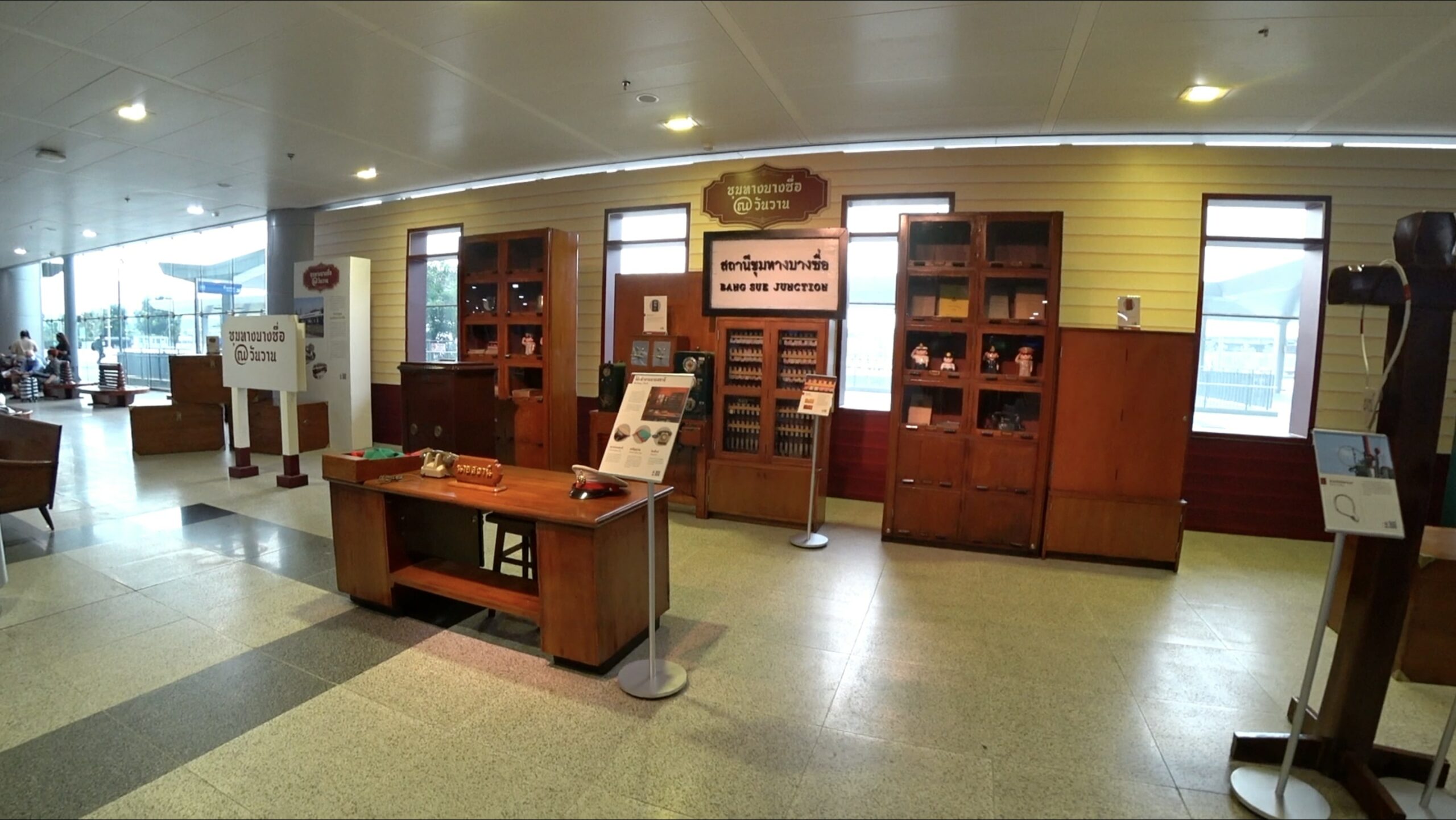
The easiest way to get to Nong Khai is by train using the SRT (State Railway Thailand). It will cost you anywhere between 200-1000 baht depending on the ticket you get. 3rd class non-AC is cheapest at around 300 baht, whereas you’ll pay around 700-900 for a sleeper AC seat. If you want a sitting 2nd class AC seat it will be 300 baht.
You could also get the bus, but I’m not sure why you’d want to do this as it’s a similar price and takes longer.
Crossing The Border in Nong Khai
To cross the borer in Nong Khai do this:
- Get Tuk Tuk to border crossing
- Walk across (left side)
- Stamp out at immigration
- Get bus across bridge (30 baht/ticket)
- Fill in forms on Laos side
- Pay 1800 baht for 30-day visa
For more information on what you need to cross and how to cross, check our in-depth article here.

I’m Harry – and I was tired of the same old “10 best places I’ve never been but I’m writing about for some reason” blog posts. So… I’m a young traveller on a mission to travel the world and share my true, unfiltered experience, including all the gristly details. From packing my life into one bag for a year, to traveling Vietnam by motorbike, to sorting out Visas for specific countries – I’ve done it all, am doing it all and only give my advice on things I have done – not regurgitated cr*p from another source *cough* most publications *cough*. So bear with us! This project will take some time to grow, and will take a fair bit of money. But I’m determined to make it the single best source of information about traveling on the internet.
